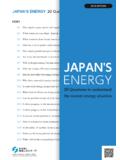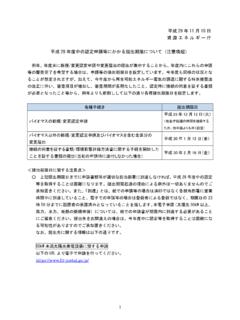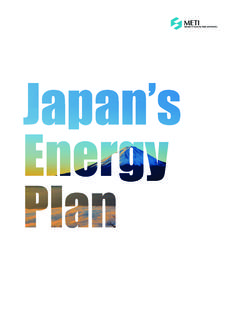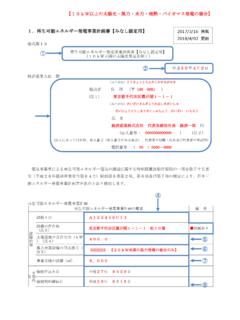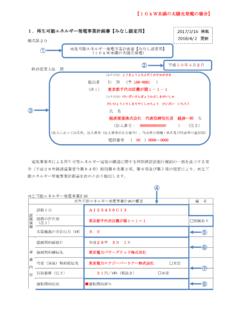Transcription of Strategic Energy Plan - Minister of Economy, Trade and ...
1 Provisional Translation Strategic Energy plan April, 2014. 0. Table of Contents Introduction .. 4. Chapter 1. Issues related to the Energy supply-demand structure in Japan .. 7. Section 1. Structural issues faced by Japan .. 7. 1. Fundamental vulnerability of the Energy supply system due to high dependency on overseas Energy resources .. 7. 2. Mid- to long-term changes in the Energy demand structure through population decrease and technological innovation, etc.. 7. 3. Instability of resource prices due to increased Energy demand in emerging countries, etc.
2 7. 4. Increasing global greenhouse gas emissions .. 8. Section 2. TEPCO's Fukushima Nuclear Accident and issues that become apparent around the time of the accident .. 9. 1. Concerns over serious damage caused by the TEPCO's Fukushima nuclear accident and the safety of nuclear power generation .. 9. 2. Outflow of national wealth and increased supply instability due to higher dependency on fossil fuels .. 9. 3. Higher electricity bills due to a change in the power source mix, and the impact of the international regional differences in Energy price on the macro economy, industry and household economy.
3 10. 4. Rapid increase in greenhouse gas emissions in 5. Exposed defects related to supply systems, including power interchange and emergency supply between eastern and western Japan ..11. 6. Reduced confidence in the government and business operators involved in Energy supply .. 13. 7. Changes in the demand trend - Increased introduction of cogeneration and changes in power saving actions .. 13. 8. Change in the geopolitical structure of resource-supplying regions, including instability in the Middle Eastern and North African regions.
4 14. 9. Signs of a change in the global Energy supply-demand structure caused by the shale revolution in North America .. 14. 10. The global expansion of nuclear power introduction mainly in emerging 15. Chapter 2 Basic policy regarding measures concerning Energy supply and demand .. 17. Section 1. Principles for the Energy policy and viewpoint of 17. 1. Confirmation of the basic viewpoint of the Energy policy (3E + S) .. 17. 2. Building a "multilayered and diversified flexible Energy supply-demand structure" and policy direction.
5 18. Section 2. Position of each Energy source and policy timeframe .. 21. 1. 1. Position of each Energy source in the primary Energy structure and its policy direction .. 21. 2. Principles of the secondary Energy 27. 3. The relationship between the policy timeframe and the Energy mix .. 30. Chapter 3. Long-term measures regarding Energy supply and demand to be implemented in a comprehensive and systematic manner .. 31. Section 1 Promotion of comprehensive policy toward securing stable supply of resources .. 31.
6 1. Reinforcement of relations with resource-supplying nations, including North American and African nations and Russia and promotion of participation in upstream projects .. 31. 2. Reinforcement of the foundation of the current procurement environment .. 32. 3. Improvement of terms of resource procurement to lower Energy cost .. 33. 4. Promotion of development of domestic resources such as methane 34. 5. Promotion of recycling essential for securing stable supply of mineral resources and reinforcement of the stockpiling system.
7 36. Section 2. Realization of an advanced Energy -saving society and smart and flexible consumer activities .. 37. 1. Enhancing Energy efficiency in each sector .. 37. 2. Leveraging demand response that promotes efficient Energy supply .. 40. Section 3. Accelerating the introduction of renewable Energy : Toward achieving grid parity over the mid- to long-term .. 42. 1. Strengthening measures to accelerate the introduction of wind and geothermal power .. 42. 2. Promotion of use of renewable Energy in distributed Energy systems.
8 44. 3. Feed-in-tariff system .. 46. 4. Establishing Fukushima as a center of the renewable Energy industry .. 46. Section 4. Re-establishment of the nuclear Energy policy .. 47. 1. Starting point of the nuclear Energy policy Sincere reflection on the TEPCO's Fukushima nuclear accident .. 47. 2. Efforts toward restoration and reconstruction of Fukushima .. 47. 3. Untiring pursuit of safety and establishment of stable environment for nuclear operations .. 49. 4. Steady approach without putting off implementing measures into the future.
9 51. 5. Establishment of confidential relationship with people, nuclear host municipalities and international community .. 54. Section 5. Environmental arrangement of an environment for efficient and stable use of fossil fuels .. 57. 1. Promotion of effective use of high-efficiency coal and gas thermal power generation .. 57. 2. Restructuring the business foundation of the oil and LP gas industries .. 57. Section 6. Promotion of reforms in the supply structure to remove market barriers .. 60. 2. 1. Carrying out the electricity system reform.
10 60. Section 7. Enhancing resilience of the domestic Energy supply networks .. 63. 1. Reinforcement of response to supply crises from abroad through oil stockpiling, etc.. 63. 2. Reinforcement of response to domestic crises (such as disaster risk) .. 63. 3. Securing stable supply in normal times .. 66. Section 8. Future of the secondary Energy structure such as hydrogen that contributes to stable supply and global warming countermeasures .. 67. 1. Promotion of cogeneration to more efficiently use electricity and promotion of introduction of storage batteries.
